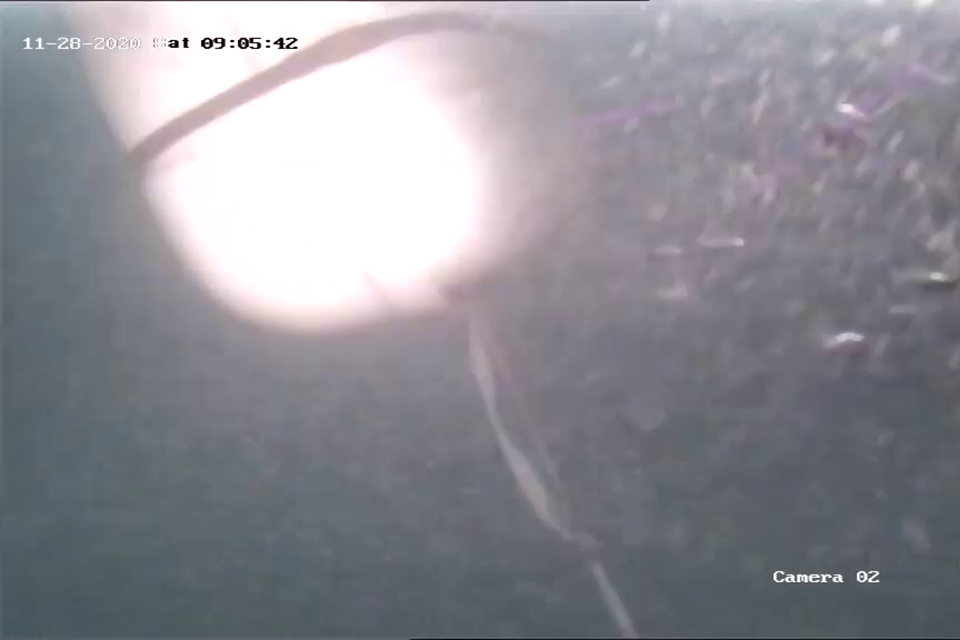Safety flyer to the fishing industry - Joanna C
Published 22 June 2022
1. Summary
Capsize and sinking of the scallop dredger, Joanna C (BM 265), with the loss of two lives, on 21 November 2020

The scallop dredger Joanna C at sea
2. Narrative
Early in the morning on 21 November 2020, in darkness and windy conditions, the crew of the scallop dredger, Joanna C, was recovering the dredges, full of catch, back on board. As the gear emerged out of the water, the skipper realised that the starboard dredge bar was snagged on a potting line. At the same time, Joanna C started to heel to starboard and then rapidly capsized.
The mate, who was on deck, was thrown into the sea, but the skipper and deckhand were initially trapped inside the floating, upturned hull. After about 40 minutes, the skipper managed to escape as Joanna C sank, but the deckhand remained trapped inside. Once at the surface, the skipper found the mate, who was very cold and tangled in a rope.
Only the skipper survived this accident. The deckhand was unable to escape from the upturned boat and his body was recovered from the wreck by divers the following day; the mate’s body washed up ashore sometime later.
3. Safety Lessons
-
Modifications will alter a vessel’s stability characteristics. Joanna C capsized because it had insufficient reserve of stability to counter the effect of the heel created by the starboard dredge becoming snagged. Post-accident analysis identified that multiple modifications over many years had eroded Joanna C’s stability condition from one of being very satisfactory, to that of failing the required criteria by a wide margin. When considering any modifications to a fishing vessel, it is vital that the potential effect on stability is considered.
-
Professional advice from a naval architect and informing the Maritime and Coastguard Agency (MCA) of your modification plans are key processes to ensure that fishing boats are operating safely with a sufficient margin of static stability to counter the dynamic effects of wind, waves or, as on this occasion, heeling as a result of snagging. It is potentially unsafe to continue fishing operations if there is any uncertainty over a vessel’s stability characteristic, such as awaiting the results of a post-modification inclining experiment.
-
Automatic lifesaving appliances need to be arranged so that they float free and aid survivors. After Joanna C sank, the float free liferaft was released from its cradle by the Hydrostatic Release Unit (HRU) but did not subsequently inflate (see figure). This meant that it did not come to the surface to provide refuge for the skipper and mate, adversely affecting their chances of survival.
-
The liferaft did not inflate because it was a model intended for use in the leisure industry and was not manufactured to meet any design standard. This meant that there was no guarantee that the liferaft would have sufficient buoyancy to overcome the pull required on the painter to initiate the inflation mechanism.
-
At the time of this accident, the carriage of a liferaft that did not meet any industry standard was acceptable under the small fishing vessel regulations. However, the safety lesson from this accident is that it is vital to check that, where ‘float free’ arrangements are in place, the buoyancy of the liferaft will be sufficient to overcome the inflation mechanism, when released from the cradle.

Still from dive survey video showing that the liferaft had been released from the cradle and was floating, uninflated at the end of the painter. The bottom of the canister can be seen in the top-left of the image
Our accident investigation report is available at: https://www.gov.uk/maib-reports/capsize-and-sinking-of-scallop-dredger-joanna-c-with-loss-of-2-lives.
Extract from The United Kingdom Merchant Shipping (Accident Reporting and Investigation) Regulations 2012 – Regulation 5:
The sole objective of the investigation of an accident under the Merchant Shipping (Accident Reporting and Investigation) Regulations 2012 shall be the prevention of future accidents through the ascertainment of its causes and circumstances. It shall not be the purpose of an such investigation to determine liability nor, except so far as is necessary to achieve its objective, to apportion blame.
Note:
This safety flyer is not written with litigation in mind and, pursuant to Regulation 14(14) of the Merchant Shipping (Accident Reporting and Investigation) Regulations 2012, shall be inadmissible in any judicial proceedings whose purpose, or one of whose purposes is to attribute or apportion liability or blame.
Marine Accident Investigation Branch
First Floor, Spring Place
105 Commercial Road
Southampton
SO15 1GH
Email iso@maib.gov.uk
Enquiries during office hours +44 (0)23 8039 5500

